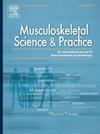Associations between left/right judgment task performance and psychosocial pain factors in women with fibromyalgia: A cross-sectional study
IF 2.2
3区 医学
Q1 REHABILITATION
引用次数: 0
Abstract
Background/objectives
Fibromyalgia (FM) is a chronic pain condition characterized by widespread pain and associated with psychosocial factors such as kinesiophobia and catastrophizing. This study aims to identify psychosocial variables that explain variance in left/right judgment task (LRJ) performance in women with FM and to compare LRJ performance between women with low pain intensity and those with moderate-high pain intensity.
Methods
A cross-sectional study was conducted with 56 women recruited from a rehabilitation foundation. Pain intensity, kinesiophobia, and catastrophizing were assessed using validated instruments, including the Visual Analog Scale (VAS) and the Tampa Scale for Kinesiophobia. LRJ tasks were performed with Recognise™ software, measuring reaction time (RT) and accuracy (AC). Data were analyzed with multiple linear regression models and Mann-Whitney U tests to examine variables that explained variance in LRJ performance and to compare groups with low versus moderate-high pain intensity.
Results
Age and kinesiophobia significantly explained variance in RT, accounting for up to 10.2 % of the variation. Pain intensity explained 21 % of the variance in AC when combined with age. Significant differences in RT and AC were observed between women with low pain intensity and those with moderate-high pain intensity.
Conclusions
Age, pain intensity, and kinesiophobia influence LRJ performance in women with FM, supporting the hypothesis of an altered body schema in this population. These findings emphasize the need for comprehensive treatment that addresses both physical and psychosocial factors, and suggest that LRJ-based strategies could be further explored as complementary tools in rehabilitation.
纤维肌痛女性左/右判断任务表现与心理社会疼痛因素之间的关系:一项横断面研究
背景/目的:纤维肌痛(FM)是一种以广泛性疼痛为特征的慢性疼痛,并与运动恐惧症和灾难化等社会心理因素相关。本研究旨在找出解释FM女性左/右判断任务(LRJ)表现差异的社会心理变量,并比较低疼痛强度和中高疼痛强度女性的LRJ表现。方法:从康复基金会招募56名妇女进行横断面研究。疼痛强度、运动恐惧症和灾难化使用经过验证的工具进行评估,包括视觉模拟量表(VAS)和运动恐惧症的坦帕量表。LRJ任务由recognition™软件完成,测量反应时间(RT)和准确度(AC)。采用多元线性回归模型和Mann-Whitney U检验对数据进行分析,以检验解释LRJ表现差异的变量,并比较低疼痛强度组与中高疼痛强度组。结果:年龄和运动恐惧症显著解释了RT的差异,占变异的10.2%。当与年龄相结合时,疼痛强度解释了21%的AC差异。在疼痛强度低的女性和疼痛强度中高的女性之间观察到RT和AC的显著差异。结论:年龄、疼痛强度和运动恐惧症影响FM女性的LRJ表现,支持该人群身体图式改变的假设。这些研究结果强调了综合治疗的必要性,解决了生理和心理因素,并表明基于lrh的策略可以进一步探索作为康复的补充工具。
本文章由计算机程序翻译,如有差异,请以英文原文为准。
求助全文
约1分钟内获得全文
求助全文
来源期刊

Musculoskeletal Science and Practice
Health Professions-Physical Therapy, Sports Therapy and Rehabilitation
CiteScore
4.10
自引率
8.70%
发文量
152
审稿时长
48 days
期刊介绍:
Musculoskeletal Science & Practice, international journal of musculoskeletal physiotherapy, is a peer-reviewed international journal (previously Manual Therapy), publishing high quality original research, review and Masterclass articles that contribute to improving the clinical understanding of appropriate care processes for musculoskeletal disorders. The journal publishes articles that influence or add to the body of evidence on diagnostic and therapeutic processes, patient centered care, guidelines for musculoskeletal therapeutics and theoretical models that support developments in assessment, diagnosis, clinical reasoning and interventions.
 求助内容:
求助内容: 应助结果提醒方式:
应助结果提醒方式:


